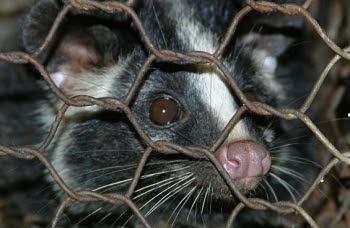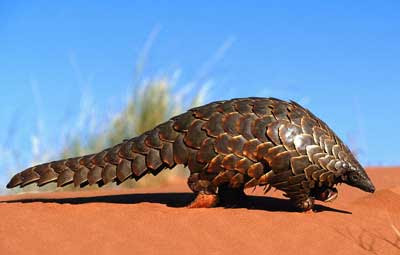Author:Walter Parham
Consuming endangered wildlife is illegal in China, but it continues on a large scale in the country’s south. Walter Parham reports on a habit that locals just cannot kick – even after the SARS crisis.
The destruction of south China’s wildlife habitats started about 1,000 years ago, and still continues today. This led to many animal extinctions and severe reductions in wildlife populations, and has been compounded by the use of wildlife for food and for ingredients in Traditional Chinese Medicine (TCM).
One might imagine that the pressure on wildlife would have decreased as levels of education and urban incomes have risen in the region. But the greatest reduction in wildlife consumption was actually in 2003, and came as a result of public fears about the risks of catching Severe Acute Respiratory Syndrome (SARS) from wild animals. In late 2004, the demand for civet cats decreased so much due to the fear of SARS that 141 farms released 4,000 of the animals into the wild.
Bird flu later added to this concern.
Many Chinese people believe that eating wildlife is a bad habit, and some will even say it is barbaric, but the practice has persisted in China for around 2,000 years. A 2003 poll taken in Guangdong province found that half of the population had eaten wildlife, snake being named as the favourite of 45% of those surveyed.

A caged masked palm civet for sale in a Guangzhou wild-animal food market in 2006
(Photo courtesy of Animals Asia Foundation, Hong Kong)
With increased affluence in large south China cities such as Hong Kong, Shenzhen, and Guangzhou, greater numbers of well-educated urban men have been reported as travelling to other cities on the Chinese mainland to enjoy feasts of endangered and protected wildlife species – in order to flaunt their wealth. Feast menus typically include cobras and other poisonous snakes, pangolins (a small, scaly animal) and civet cats.
The figures are staggering. Twenty tonnes of snakes and as many as 20,000 birds were eaten every day in Guangdong restaurants in 2001, reported the South China Morning Post. One Guangzhou restaurant, “Chock Full O’Snakes”, served 600 to 700 kilograms of snakes every day throughout January 2001 – the first month of the Year of the Snake. Some wildlife restaurants in Guangzhou can seat as many as 1,000 people.
In 2001, China announced fines of 1,000 to 10,000 yuan for anyone caught eating protected wildlife. But in 2004 Xinhua news agency reported the State Forestry Administration as saying that the cobra population has fallen 90% in the previous decade, while numbers of the common rat snake had dropped 75%.
The scarcity of wildlife in Guangdong province, stemming from the high demand for wild animals for food, has meant increasing imports of wildlife from other southern provinces, as well as other Asian countries such as Indonesia, Thailand, Malaysia, India and Vietnam – and even some African countries. These imports increase the pressure on wildlife in these locations.
Smuggling has also become commonplace in nearby Hong Kong, due to the high market value of many endangered or protected wildlife species in mainland China. A look at some Hong Kong police reports highlights the magnitude of the problem: in 2001, the Hong Kong authorities uncovered a shipment of 2.7 tonnes of pangolin scales, a yield that would require the scales of 5,000 to 6,000 pangolins. The next year, crates containing 600 cobras were smuggled into Hong Kong from Malaysia, but were intercepted by the police by a dangerous, high-speed boat chase. And in 2005, a shipment of 1,800 skinned and vacuum-packed pangolins was discovered. The list goes on, and these incidents only represent the tip of the iceberg of the wildlife smuggling trade.

Pangolin
The 2003 SARS outbreak caused widespread concern in China about the possible hazards of eating wild animals. The link between SARS and the handling and eating of certain wildlife was proposed by medical researchers, and the Chinese government closed or relocated a number of wildlife markets, as well as closing many wildlife restaurants. At the height of the outbreak, the Guangdong government banned the breeding, consumption and trading of wildlife. But sales resumed shortly after the SARS crisis had passed. Renewed efforts by the Guangdong health authorities in 2007 to confiscate civet cats led to a haul of 15 civet cats and 22 kilograms of civet-cat cutlets. Health authorities in the Guangdong city of Foshan recently banned the eating of field mice, after vendors were found to have killed the mice with poison before selling them to restaurants.
Although recent evidence suggests that wildlife consumption has slowed, there is also reason to believe that smuggling continues. If something on the scale of a SARS outbreak does not resurface, will the public become increasingly complacent about eating wild animals again? And will environmental education alter people’s eating habits and reduce wildlife consumption? We can only hope, but I am not so certain.
Walter Parham, Ph.D. (University of Illinois in geology/clay mineralogy) has conducted research part-time in China and Hong Kong for around 40 years. His affiliations include among others the Federation of American Scientists’ director of China Tropical Lands Research, the University of Hong Kong’s Kadoorie Agricultural Research Centre, and the South China Agricultural University in Guangzhou.
Source:
http://www.theecologist.org/archive_detail.asp?content_id=1012
No comments:
Post a Comment